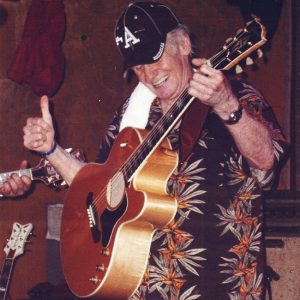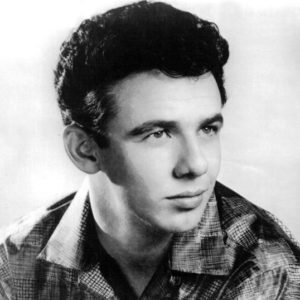calsfoundation@cals.org
Dale Hawkins (1938?–2010)
aka: Delmar Allen Hawkins
Delmar Allen (Dale) Hawkins Jr., a member of the Rockabilly Hall of Fame, specialized in creating a sound (called “Swamp Rock” by some) that helped shape rock and roll music. Hawkins was successful in many roles in the music industry: singer, songwriter, recording artist, producer, arranger, band leader, musician, TV host, disc jockey, and promoter. Billboard magazine lists Hawkins’s Suzie Q album in its Top 100 most valuable albums in the development of rock and roll. His first cousin, Ronnie Hawkins, rose to fame with the musical group the Band.
Different sources have reported different birth dates for Hawkins (given the practice in the 1950s for promoters to alter birth dates to make their clients more appealing to a younger audience), but he was most likely born on August 22, 1938, on Goldmine Plantation in Louisiana. His father, Delmar (Skipper) Hawkins was a road musician and, at one time, a member of the Sons of the Pioneers, while his mother, Estelle Taylor Hawkins, was a teacher. He had one brother, Jerry, who went on to become a recording artist on Ebb records and head the Musicians Union in Shreveport, Louisiana. Hawkins’s father left when Hawkins was three years old. Although Hawkins grew up not knowing his father, he spent much of his youth with his father’s family on his aunt Annabel Hawkins’s farm and attended a few years of school in St. Paul (Madison County).
Hawkins often listened to Hank Williams and Hank Snow on the radio. He learned about gospel music at a church in St. Paul and from musicians he met in Louisiana. He learned blues music while picking cotton in Louisiana, with country blues singers, and by following his maternal grandfather, federal marshal Jessie Clinton Taylor, on his rounds to clubs and cafés. Hawkins bought his first guitar at the age of thirteen with money he earned selling Grit newspapers.
Hawkins joined the navy at the age of sixteen and served for a year and a half. He moved to Bossier City, Louisiana, and, while attending college, worked part time at Stan’s Record Shop in Shreveport. There, he met Leonard Chess (Chess Records/Checker Records) and later recorded his first hit on Chess’s Checker label, the self-penned “Suzie Q” (1957). Stan Lewis, owner of Stan’s Record Shop, and E. Broadwater also received co-writing credits, though in a later interview, Hawkins stated that the writing credits were taken out of his control and should have been given to himself and James Burton.
Hawkins was one of the few white artists who recorded for Checker, a label that produced rhythm and blues records. Hawkins performed at the Apollo Theater in New York City two weeks before the reputed first white artists, Buddy Holly and the Crickets, arrived on the scene.
Hawkins’s records charted four times between 1957 and 1959: “Suzie Q” (1957), “La-Do-Dada” (1958), “A House, a Car and a Wedding Ring” (1958), and “Class Cutter (Yeah, Yeah)” (1959).
Hawkins nurtured many great guitarists in his band, including Rock and Roll Hall of Fame member James Burton; Fred Carter Jr., who later went to work for Ronnie Hawkins; and Roy Buchanan. Hawkins gave Joe Osborn his first gig as a session guitarist on “La-Do-Dada.” Other band members were future Newbeats Dean and Marc Mathis; Country Music Hall of Fame and Rock and Roll Hall of Fame member Floyd Cramer; Rock and Roll Hall of Fame member Scotty Moore; Rockabilly Hall of Fame member Dominic Joseph (D. J.) Fontana; Carl Adams; and Kenny Paulsen.
In 1960, Dick Clark helped Hawkins become the host of The Dale Hawkins Show, featuring rock and roll music and teenage dancers on WCAU-CBS TV in Philadelphia, Pennsylvania. The show lasted a year and a half.
Hawkins married Paulette Hale in 1962, and they had two sons.
In the mid-1960s, Hawkins moved into the production side of records. He went back to Shreveport and worked for Stan Lewis’s Jewel and Paula record labels. He undertook all aspects of the record production process, including road work to promote the records. During this time, Hawkins worked with Joe Stampley and the Uniques on “Not Too Long Ago” (1965) and “All These Things” (1966). In 1966, he moved to Tyler, Texas, to become president of ABNAK Records. He produced a big hit for the Five Americans, “Western Union” (1967), as well as John Fred and the Playboys’ “Judy in Disguise (With Glasses)” (1968), and Bruce Channel’s “Mister Bus Driver” and “Keep On” (1968). While in Texas, Hawkins served as Southwest vice president of Columbia Records.
In 1968, he moved to Los Angeles, California, to become RCA’s West Coast Head of A&R (Artist & Repertoire). For the next three years at RCA, he worked with artists such as Harry Nilsson and Michael Nesmith.
In the early 1970s, Hawkins got hooked on prescription drugs and moved his family back to Louisiana. He and Paulette divorced. In the late 1970s, Hawkins battled chemical dependency at a Veterans Administration hospital. He moved to Arkansas in 1978.
Filmmaker Moe Emerson of El Dorado (Union County) produced a thirty-minute profile of Hawkins for the Arkansas Educational Television Network (AETN) in 1989. During the 1990s, Hawkins worked as a volunteer disc jockey for community radio station KABF and was a featured performer at White Water Tavern in Little Rock (Pulaski County). Hawkins was also featured on VH-1’s Where Are They Now? in the mid-1990s.
Hawkins co-starred in a 120-minute documentary by filmmaker Robert Mugge, Rhythm ‘N’ Bayous: A Roadmap to Louisiana Music. He continued to compose, record, and produce his own music, releasing the album Back Down in Louisiana in 2007.
He lived in North Little Rock (Pulaski County) for more than twenty years, recording at his Hawk’s Nest Studio.
Hawkins died on February 13, 2010, in Little Rock. He is buried at Riverside Cemetery in St. Paul.
For additional information:
Dewitt, Howard A. “Dale Hawkins: Oh Suzie-Q and Beyond.” Blue Suede News (Fall 1997): 16–22.
Laffoon, Janis. “An Interview of Dale Hawkins” Nightflying (October 1987): 11–13.
Martin, Douglas. “Dale Hawkins Dies at 73; Rockabilly Author of ‘Susie Q.’” New York Times, February 18, 2010. Online at http://www.nytimes.com/2010/02/18/arts/music/18hawkins.html?_r=0 (accessed September 7, 2023).
Marymont, Mark “Hawkins Begins TV Enterprise with ‘Risky Fifties’ Collection.” Arkansas Democrat-Gazette, February 26, 1989, p. 4G.
———. “‘Suzie-Q’ among 100 Most Valuable Albums.” Arkansas Gazette, September 17, 1989, p. 5G.
Billie J. Abbott
Cabot, Arkansas
 Dale Hawkins
Dale Hawkins  Dale Hawkins
Dale Hawkins 




Comments
No comments on this entry yet.